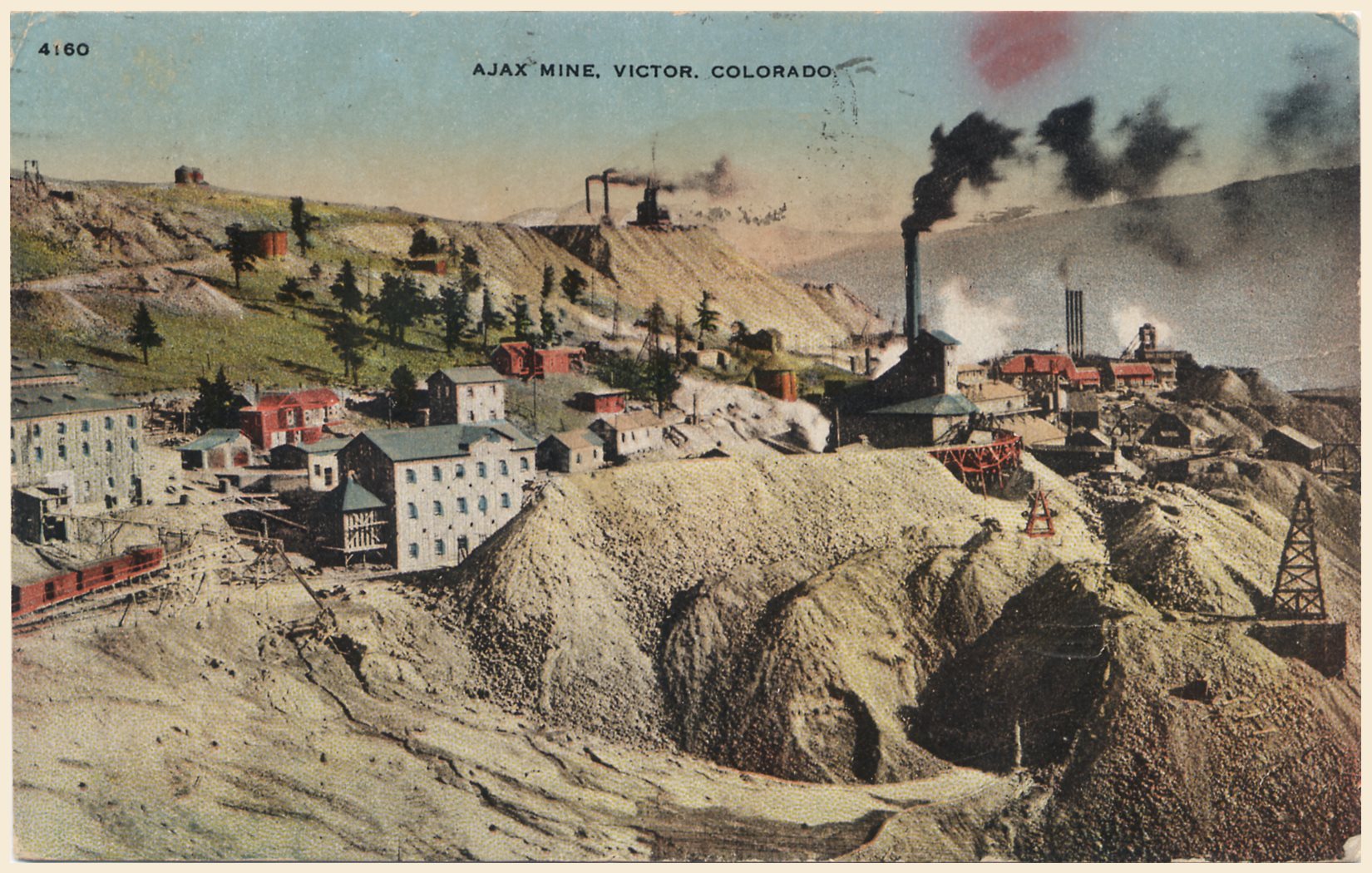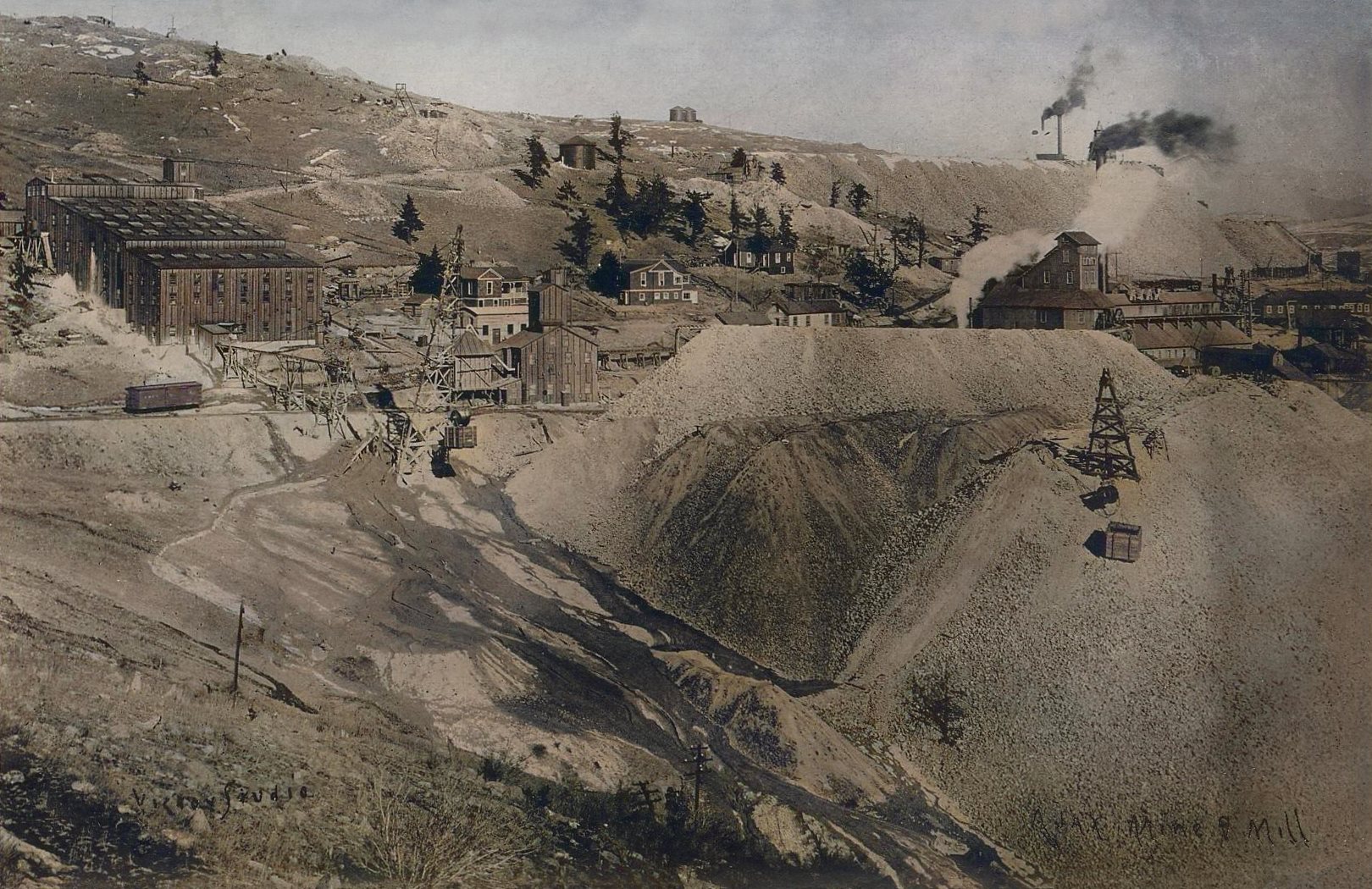-> HathiTrust Digital Library Site; Link to First Page.
Source had no pics, only text, so I reused images from my collection.
The Clancy method of cyanidation of gold ores is soon to have its merits thoroughly proved in the Colburn mill which is now being built at the Ajax mine in Cripple Creek. The mill will be running before the end of the year, and outside of the use of the Clancy process, it possesses several interesting features.
The plant is being built not only to handle the lower grades of ores from the Ajax mine, but the present mine dump as well, or the greater part of it. The dump is estimated to contain 200,000 to 300,000 tons of rock that will assay between $3 and $5 per ton. The average would probably be close to $4.
The Ajax dump probably runs higher than the average in the district, because the ore produced by the mine was very closely sorted before shipping, and none but merchantable ore sent out.
The mill will handle the run of mine ore after a rough preliminary sampling, and product of the lessees as well as that mined on company account to be treated. The very rich ore will not be milled.
The plant will have a splendid and economical system for handling the dump material. A large drag bucket, running on a wire rope supported by two towers, will be operated by an engineer, who will be stationed above the receiving bin at one end of the cable-way, where he will be able to see the whole of the dump as well as the receiving bin.
The drag bucket will be self-filling and self-dumping, being operated on the same principle as the steam shovels of a dredge. At the receiving bin a rough sorting will take place and the waste rock thrown out.
From this station the ore will be transported by motor car to the crusher house, where it will be crushed to about 12 mesh, a Symons gyratory and three sets of Allis-Chalmers 16x36 rolls being used. The sample will be taken by Snyder samplers. A bag-house system has been attached to the crusher house for the purpose of removing the dust, which is done by powerful suction fans.
The dust is emptied into a room lined with burlap, and is separately conveyed to the cyanide department. The ore will carry very little dust after it leaves the crusher plant. This system is expected to save values which would otherwise be lost.
From the crushing plant the ore will be elevated to the cyanide building by a belt conveyor 300 ft. long. Three large circular steel bins will receive the product, each of which will hold about 500 tons of rock. Each bin will also carry a different class of ore, the division of material being into the three classes of high grade, medium, and low grade and dump material.
Each class will crush to a different mesh, the high-grade ore being crushed to about 200 mesh; the medium to 120 to 150; and the low-grade to 80 to 100 mesh. From the tube mills the material will all be thrown together, as it has been calculated that about the same length of treatment in the agitators will enable the same percentage of extraction.
There are five agitating tanks, the design being of a special type adapted to the application of the Clancy process. The agitation is entirely by air, and during the process electricity will be applied to aid in extracting the gold and in regenerating the solution.
The time of agitation will be from 18 to 24 hours. From the agitators the slimes are handled by the Moore filter plant, and after filtering the gold is precipitated by the zinc dust process, this having been found to be more effective than zinc shavings. Very uniform results are expected from the operation of the plant.
Mine operators are more or less familiar with the Clancy process, which is based principally upon the use of calcium cyanamide, which is used for regenerating the active chemical. Cyanamide is manufactured by electrical methods, and its cost is claimed to be not more than one sixth that of cyanide.
Furthermore, by the use of potassium iodide, the necessity for fine crushing of the ore will be obviated. Extensive tests of this process were made by the Ajax people before determining upon its use in the Colburn mill.
The consumption of potassium iodide is about 1 oz. to the ton of ore; the consumption of cyanamide will be from 1½ to 2 lbs. to the ton of ore. According to tests made, the tailings will run in value from 60 cents to $1 per ton, depending upon the character of the ore. On $10 ore the tailings are expected to run about 60 cents per ton, an extraction which is substantially above 90 per cent.
A unique system will be in vogue for disposing of the tailings, which is by an automatically-operated bucket run on a wire cable-way to the top of a tower about 100 ft. high and several hundred feet away from the mill. The bucket is filled from a hopper at the end of the tailings discharge pipe, and when full operates a trip which closes the hopper. By the same movement, machinery is set in motion which carries the bucket to the end of the line, discharges the contents, brings it back to the hopper, where another trip opens the bottom and the bucket is refilled.
Throughout the plant, the operations are made as completely automatic as possible. The mill is provided with a very complete telephone system. The plant is electrically operated throughout. A current of 22,000 volts is received from the Colorado Light & Power Co., which is reduced to 440 volts in the transformer house. This transformer plant is built of solid concrete, and the wires are conveyed from it to the various parts of the mine and mill buildings in underground conduits. It is well equipped with lightning arrestors.
The mill will probably be one of the most economically operated plants in the state. The crew will consist og two men per shift in the crushing and sampling departments, and three men per shift in the mill, besides the superintendent and assayers.
The capacity of the crusher is 300 tons per day of three shifts, and that of the cyanide department 200 tons in the same length of time.
The ores from the Ajax mine run, as nearly as can be ascertained, about $20 per ton as a general average. The production is close to $300,000 per year, the tonnage being about 15,000 tons. While under the present system of operation a fair profit is being made, it is not as large as, in the opinion of the management, such a grade of ore ought to afford.
As a step in the direction of economy, the mill was projected and its building is due to the energy and acumen of Judge E. A. Colburn of Denver, president of the Ajax company. The plant will cost in the neighborhood of $60,000. This is a comparatively low cost and is due to the decrease in the expense of mill building in Cripple Creek in late years.
The Ajax mine is being worked on company account, and by about 40 sets of leasers. The ore broken down by the company is being stored for the present, awaiting the completion of the mill. Work is being carried on in all the levels from 1 to 11, the twelfth now being flooded.
The mill construction is under the supervision of S. A. Worcester, engineer for the Ajax Company, the metallurgical details being worked out by A. W. Warwick, consulting engineer for the Moore Filter Co., owners of the Clancy patents. E. A. Colburn, Jr., is local manager of the mine and mill.

Ajax Mine, Victor, Colorado.
Photo by: Julia Skolas

_ajax-mill_twstd-colored.jpg)